Creme Dilution Gene
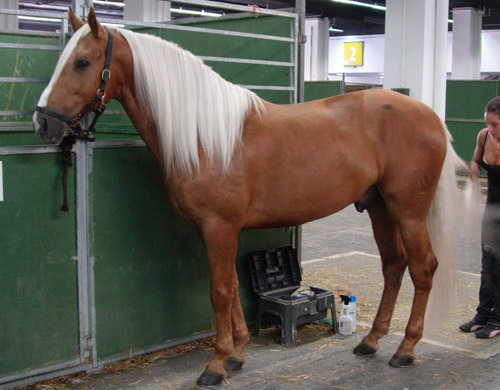
The cream dilution gene affects base colors by lightening them, a single dilution of the gene produces colors like palomino and buckskin. While a double dilution creates the light skinned cremello and smokey cream colors often mistaken for greys.
Basic Creme Gene
- Incomplete dominant gene
- Does not noticeably affect black pigment
- Dark red colors lighten to tan or yellow
- Makes chestnut and bay base coats lighter
- Bay becomes buckskin
- Chestnut become palomino
Single Dilute Creme Shades
A single creme gene can affect black, chestnut and bay animals, however it requires a double dose to have much physical affect on black animals.
Palomino
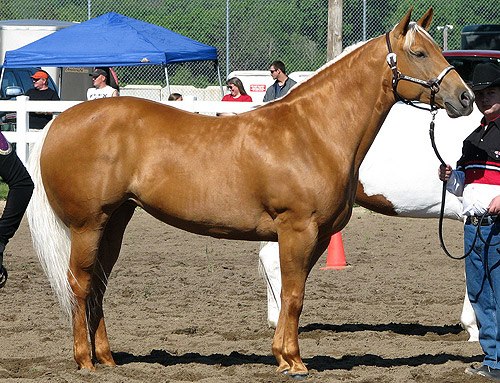
Image from Princes Milady
- Caused by one dose of cream gene diluting chestnut base
- Shades range from very light to very dark
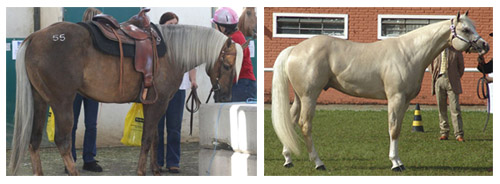
Images from Just Chaos & Reynaldo
- Light shades can appear almost white
- Darkest shades mistaken for silver dapple
- Born light and grow darker with age
- Eyes can be a light amber in color
Smokey Black
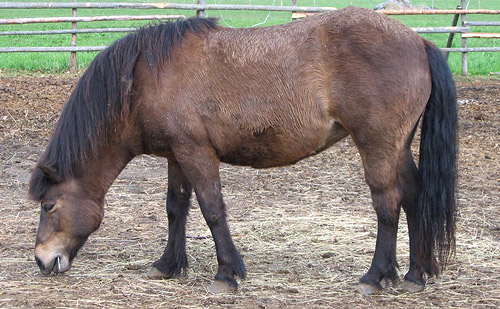
- Created by a single dose of the creme gene on a black base
- Has a slight affect on pigment
Buckskin
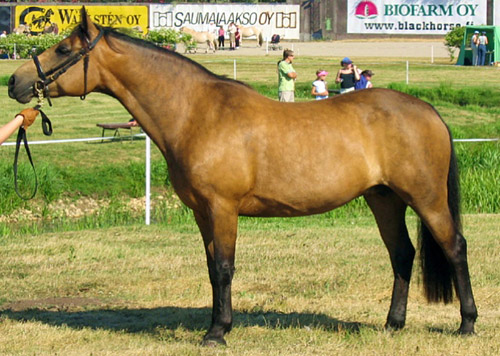
Image from Rozpravka
- Often incorrectly called with dun
- Dun and Buckskin are different genetically
- Caused by one dose of cream gene diluting a bay horse
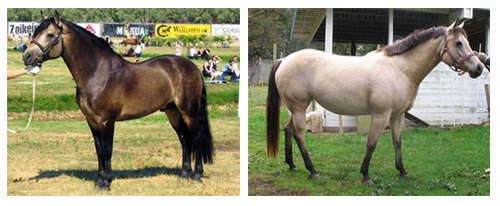
Images from Rozpravka & Derrick Coetzee
- Range from very light to very dark
- Purest form will have black points
- Dark points fade with age
Double Dilute Creme Shades
A double dose of the cream gene affects colors much more dramatically and can even make black animals almost pure white. Double cream dilutions are the most often mistaken for albinos (which don’t exist in horse genetics).
Cremello
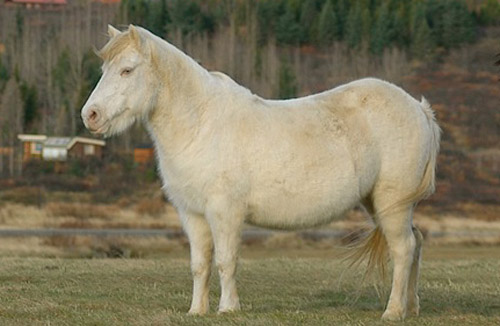
Image from Steven_Walling
- Caused by a double dose of cream gene on chestnut base
- Always have pink skin and blue eyes
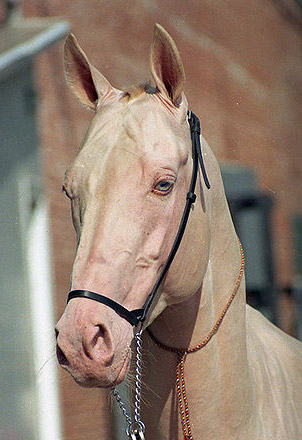
Image from HP Quarter Horses
- Often mistaken for albino horses, although the albino gene does not exist in the equine species
- Vary from almost white to a dark cream in color
Smokey Cream
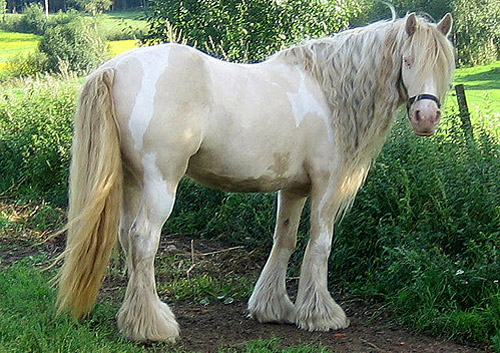
- Created by a double dose of cream gene on black base
- A double dose has a much stronger affect on a black animals
Perlino
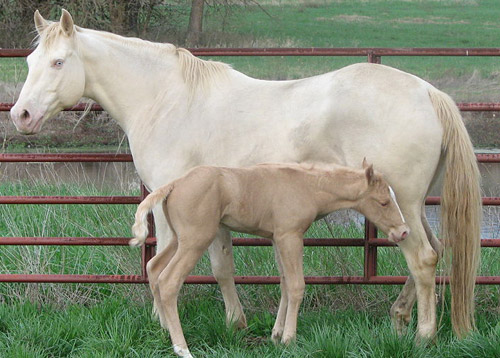
Image from Hidden Rock Ranch
- Created by a double does of cream gene on a bay horse
- Points are darker than body hair
- Blue eyes and pink skin
Mixed Dilutions
Animals can carry more than one dilution gene, (or modifier for that matter) furthering the rainbow of colors & patterns that can be found. Here are some examples.
Dunskin
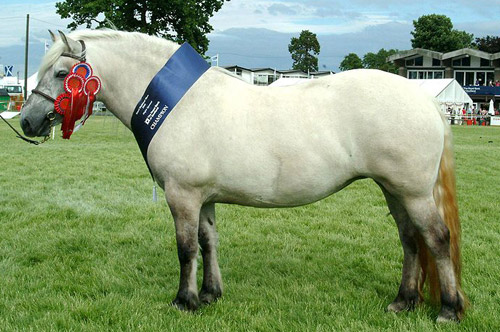
Creme & dun dilution genes on a black base
Dunalino

Dun & cream dilution genes on a chestnut base
Image of Major Heart’s Desire courtesy of Circle P Ranch
Silver Dilution Gene

Image credit Arsdelicata
One of the rarer color dilutes, the silver gene does not affect hair with red pigment. This means that it has a much more dramatic effect on a blackbase than it does on a bay horse.
Silver dapple is often confused with flaxen liver chestnuts because they both display dapples and often have creamy colored mane and tail hair.
Basic Silver Gene
- Generally called silver dapple
- Still rare, but becoming more commonly found
Different Silver Shades
Because it only affects animals with black bases, (and especially black hair) the silver effect is rather dramatic.
Silver Dapple or Chocolate Silver
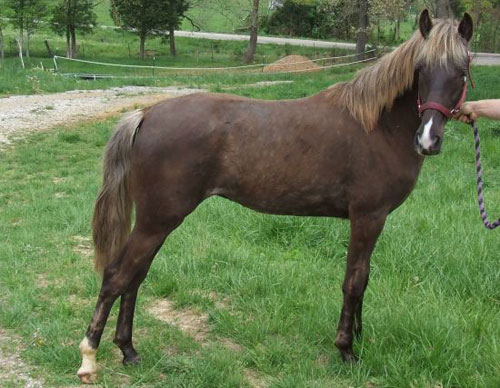
Image credit Equine Now
- Result of silver gene on black base coat
- Shetland and miniature breeds call it silver dapple
- Gaited and mountain breeds call it chocolate
- Icelandic breeders call it blue silver
- Vary from light to dark
- Light silver / gray and dappled common in pony breeds
- Also occurs in chocolate color ranging from light to dark
- May have flaxen mane and tail
- Darkest color is almost black
Silver Bay
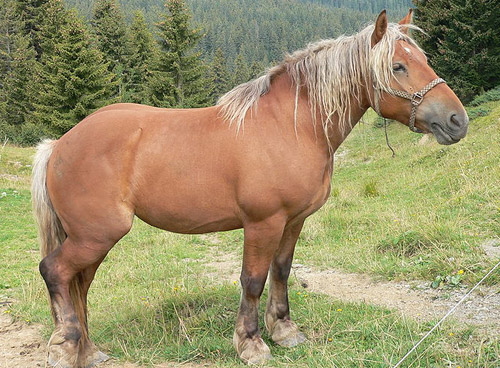
Image from Philipendula
- Result of silver gene on bay coat
- Silver gene does not physically affect red pigment
- Body color stays the same
- Dark points can be diluted
- Foals have light legs and as they age they become darker
Champagne Dilution Gene
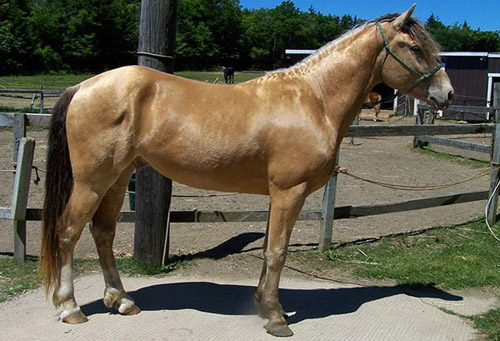
Image from Kersti Nebelsiek
The champagne gene is a rather recent discovery in the world of horse color and it has a diluting effect on both chestnut and black base coats. This pigment alteration can exhibit in a showy display of colors which often have an almost metallic sheen.
Although it should be noted that not all horses with a metallic sheen are champagne.
Basic Champagne Gene
- Sometimes born with blue eyes
- Born dark and coat lightens with age
- Sometimes born with pink skin which darkens with age
- Freckling around mucus membranes common
- Mistaken for appaloosa, sabinos and sometimes grays
- Can have reverse dappling
Different Champagne Shades
The champagne gene affects black, chestnut & bay animals to varying degrees, here are some examples.
Classic Champagne
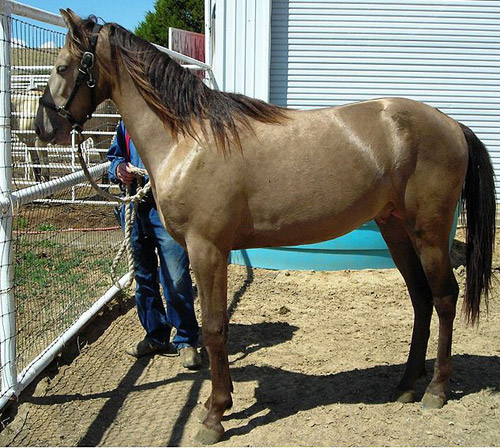
Image from Kersti_Nebelsiek
- Black horses diluted by champagne gene
- Sometimes called grullo even though they are not a true dun dilution
Gold Champagne
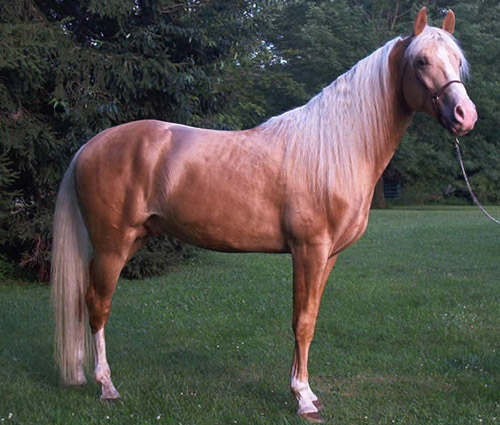
Image from Whispering Pines Walkers
Amber Champagne

Image from Kersti Nebelsiek
Mixed Dilutions
Animals can carry more than one dilution gene, (or modifier for that matter) which multiplies the color rainbow even further.
Silver Champagne
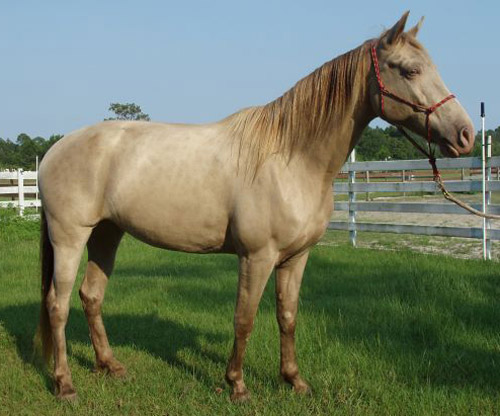
Image from Equine Now
- Black horse displaying both champagne and silver dilution genes
- Also called sweet champagne
Want to Learn More
Be sure to check out a guest post with a more complex look at the champagne gene: Equine Champagne Gene
Dun Dilution Gene
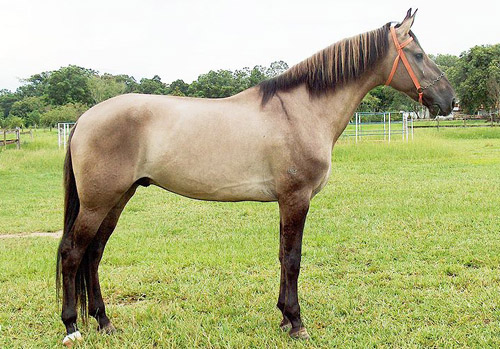
Image from Amazona
The dun dilution gene is generally quite obvious due to the specific (almost primitive) markings that indicate its presence. Some animals will display darker striping of the legs, withers and face and can be mistaken for asooty / smutty modifier.
The quick and easy way to determine a dun gene is to look for a dorsal stripe from mane to tail.
Basic Dun Gene
- Dilution gene that affects black and chestnut pigments
- Changes the physical color of black, bay and chestnut horses
- Arabian and thoroughbred don’t present dun characteristics
- Mistaken for buckskin when present on a bay base
Dun Terminology
The dun gene causes primative markings on the horse which occur in different combinations and vary from animal to animal. The images below are rather extreme examples.
Dorsal Stripe
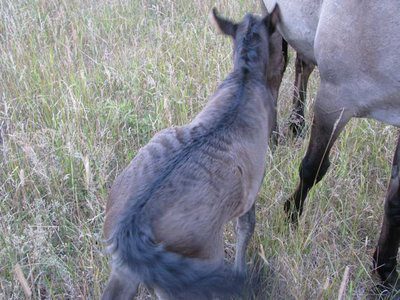
- A dark line from the base of the mane to the base of the tail
- Sometimes goes through the tail giving it a dark stripe
- Also called eel stripe, lineback, backstripe
Zebra Striping
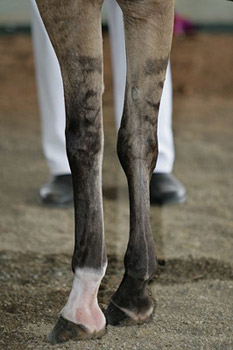
Image from Arsdelicata
- Horizontal marks on legs
- Can go above hock / knee
- May be very dark or so light they are hard to see
Shoulder Stripe
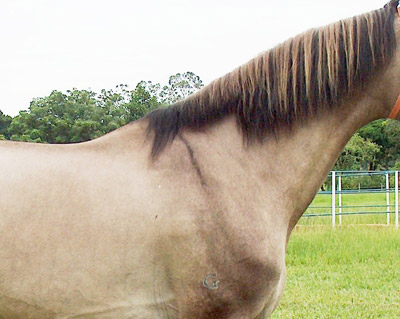
Image from Kersti_Nebelsiek
- Shading or striping over withers and shoulder can be dark or so light it is hard to see
Cobwebbing / Spiderwebbing
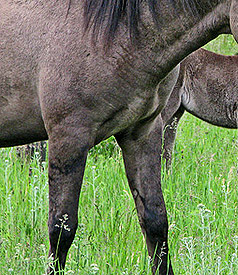
- Rings or stripes on the forehead & sometimes on the chest
Different Dun Shades
The dun dilution affects black, chestnut and bay animals and within each color a variety of shades can be displayed. Here is a little about each one.
Bay / Zebra Dun
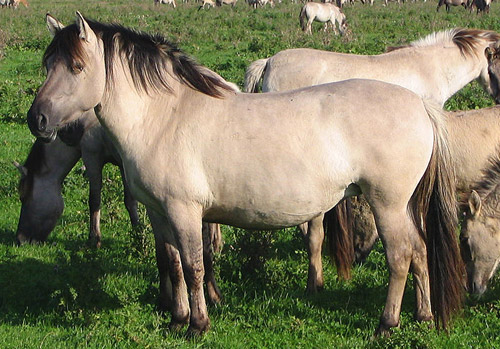
Image from Podargus
- Created by dun gene on bay coat
- Most common type of dun
- Come in many shades ranging from light to dark
- Gene dilutes body hair more so points stay darker
- Heads / face darker than rest of body
- Dilution with a combination of other genes cause a variety of colors and combinations
Red Dun
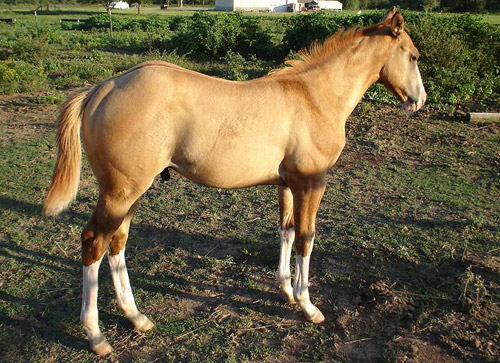
Image from Kumana @ Wild Equines
- Created by a dun gene on a red base coat
- Often confused with chestnut
- Do not have black points
- Primitive markings are distinguishing and a darker shade of red
- Shades range from light to dark
- Head darker color than body
- Light shades called ‘Claybank Dun’
Grullo or Grulla (male – female)
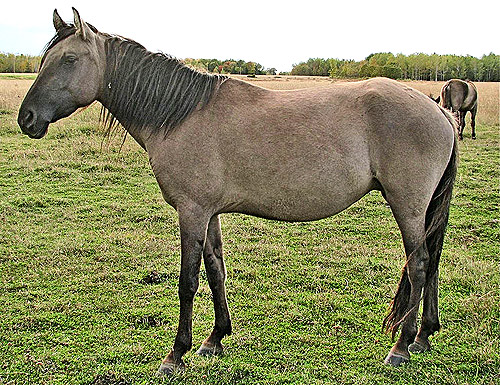
Image from LD Acres
- Created by a dun gene on a black base coat
- Grullo is Spanish word so females are referred to as Grulla
- Smoky blue color ranging from light to dark
- Black points
- Darker heads
- Primitive markings are distinguishing and black
Mixed Dilutions
Animals can carry more than one dilution gene, (and modifier for that matter) furthering the rainbow of different horse colors.
Dunskin

Perlino Dun
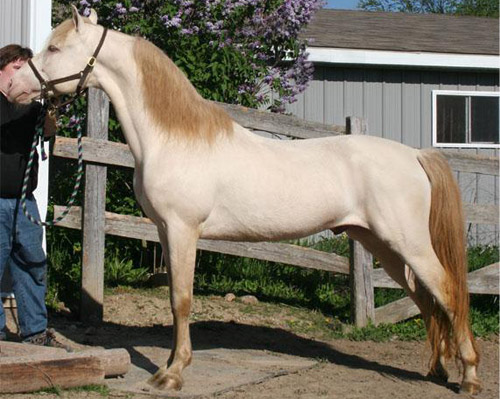
Double dose of the creme gene on a bay dun.
Image from Perlino Morgan
Dunalino

Dun & cream dilution genes on a chestnut base
Image of Major Heart’s Desire courtesy of Circle P Ranch
Rare Dilution Mixes
The stranger the genetic mix the stranger the color, but that also means that the resulting colors become very rare indeed.

Hi! Nice work!
ReplyDeleteDo you know what breed is the silver bay draft horse? And the chocolate silver above it?
Thank you ffor sharing this
ReplyDelete